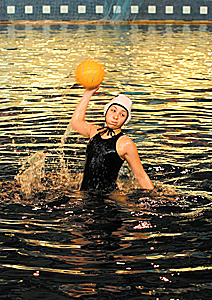Case History
The patient is a pleasant, but anxious 14-year-old female with a history of an opposing player kicking her left side, causing pain at the groin / hip region, during a water polo tournament 10 months ago.
Differential diagnosis includes lumbar disk disorder and apophysitis of pelvis / hip, where there is often dull pain in the groin or the front or side of the hip that worsens with activity. Often there will be tenderness over the injury site and sometimes some swelling. (This athlete's mother reported that localized swelling sometimes occurred after practice.)
Significant medical history and timeline of care management for the injured region included orthopedic evaluation within a managed care organization plan benefit (MCO) for suspected growth-plate injury, without any special imaging studies obtained.
 The last question you generally ask an athlete in the history when considering whether to return them to play is, "Are you ready to return to play?" In response to this question, the patient exhibited some psychological reactions to her injury by stating that she was not ready to return to her sport, she was too far behind in strength to catch up, and that even her coach did not believe her current level of pain and had told her to "buck it up and practice." History further reveals that she has been seen by physical therapists, whose care included leg-press exercises, stationary bicycle and electrical modalities.
The last question you generally ask an athlete in the history when considering whether to return them to play is, "Are you ready to return to play?" In response to this question, the patient exhibited some psychological reactions to her injury by stating that she was not ready to return to her sport, she was too far behind in strength to catch up, and that even her coach did not believe her current level of pain and had told her to "buck it up and practice." History further reveals that she has been seen by physical therapists, whose care included leg-press exercises, stationary bicycle and electrical modalities.
FABERE testing of the hip indicated dysfunction. Radiological findings of the pelvic / hip were unremarkable. The athlete was removed from sports and returned to the MCO for orthopedic re-evaluation and special diagnostic imaging.
Discussion
With low back pain of lengthy duration, a number of factors will contribute to the overall clinical picture. These may include abnormalities of the ligaments of the intervertebral joints, muscles and fascia, as well as neural structures. Low back pain is usually associated with hypomobility of one or more intervertebral segments. Due to the fact that many anatomical structures in the spine region may be the source of pain, it is often very difficult for a clinician to determine the exact cause.1
Apophysitis may be mistaken for a muscle strain. Lumbar disk herniation is included in the differentials due to sport specificity, traumatic onset and causation of radiation determination. Low back pain is a common symptom in water polo players because the amount of rotational forces is significant during throwing and passing the ball.2 Although this study was limited, the results suggest that elite athletes have a greater prevalence and greater degree of lumbar disc degeneration than the normal population.
An apophasis is a growth plate that provides a point for a muscle to attach. Growth plates are made up of cartilage cells, which are softer and more vulnerable to injury than mature bone. When the muscle attached to the apophysis is excessively tight or overworked, it can put increased tension and stress on the apophysis, which results in irritation and inflammation: a condition called apophysitis. Blunt trauma may also be a factor. There are several apophyses at the hip and pelvis that can be affected. Pelvic / hip apophysitis most commonly affects adolescents between 14 and 18 years of age.
Any of the pain-producing structures of the lumbar spine may cause low back pain, but the intervertebral discs and the apophyseal joints are the most common causes.3 Treatment of athletes with acute or chronic back pain usually is nonsurgical, and symptoms generally are self-limited. However, a systematic approach to the athlete with back pain, involving a thorough history and physical examination, pertinent imaging and treatment algorithms designed for specific diagnoses, can facilitate symptomatic improvement and return to play.3
The "eggbeater" kick characteristic of water polo training and play can also contribute to lower body injury, specifically at the knee and hip joints. The pattern of the legs in eggbeater, with abduction and internal rotation at both of these joints, places stress on the medial collateral ligament and can become inflamed.1 The eggbeater kick utilizes the following pelvic / hip muscle groups; adductor longus (origin in the symphysis and crest of the pubis) and adductor magnus (two portions: first, the ischiopubic ramus, called the "adductor portion"; and second, the tuberosity of the ischium or "hamstring portion"), quadriceps, gluteus medius and maximus, and sartorious (arises from anterior superior iliac spine). The hip abductor muscles include the gluteus medius, gluteus minimus, sartorius and tensor fascia latae muscles of the buttocks and outer thigh.
In a study addressing primary patterns of long-term groin pain in sports, adductor-related pain was considered the primary clinical entity in 119 patients ((58 percent; all men). Iliopsoas-related pain was the primary clinical entity in 73 patients (35 percent). Among women, iliopsoas-related pain was the primary clinical entity in nine cases, one woman had a snapping psoas and one had a stress fracture of the inferior pubic bone. Although prevalent among men, adductor-related pain was uncommon among females.4
Apophysitis is typically an overuse injury. Adolescents with excessively tight hip and thigh muscles are more prone to pelvis / hip apophysitis. The apophyses most commonly affected are the anterior superior iliac spine (ASIS), the anterior inferior iliac spine (AIIS) and the iliac crest. The muscles that attach to these apophyses flex the hip and rotate and twist the pelvis and trunk. Apophysitis of the pelvis / hip usually affects sprinters and ice hockey players. Diagnosis should include obtaining an X-ray to determine whether there has been a fracture to the apophysis.
Treatment Recommendations
Treatment includes rest from irritating activities until the pain and tenderness go away. Ice should be applied to the painful area for 15-20 minutes as often as every two hours until the pain subsides After daily activities can be tolerated without pain, gentle stretching and strengthening of the muscles that attach to the affected apophysis (the hip flexors and abdominal muscles) can begin. Once flexibility and strength have improved, sport-specific activities can begin with gradual progression to full activity.
Return-to-play precautions recommend that the goal is to return to sport or activity as quickly and safely as possible. Returning to activities too soon or playing with pain may cause the injury to worsen. This could lead to chronic pain and difficulty with sports. Recognition that every athlete recovers from injury at different rates is a key in case management. Returning to sport or activity will be determined by how soon an athlete's injured area recovers, not by how many weeks it has been since the injury occurred.
Psychological interventions such as imagery and instruction in positive-reinforcement skills with the injured athlete will positively influence their recovery. Recovery is not complete until the athlete can return to "normal" functional or competitive levels within the sport.
Assessment of sport-specific dietary intake (e.g., carbohydrate intake levels) is also essential in the athlete's recovery process. The nutrient most necessary for replacement during vigorous exercise is glycogen because of the demands on the phosphagen anaerobic system and fast glycolytic anaerobic system. A study featuring all members of the Greek national swimming and water polo teams demonstrated that for muscular efficiency, water polo athletes (both genders) consumed too much fat and too little carbohydrate.5
References
- Brooks JM. Injuries in water polo. Clin Sports Med, 1999;18:313–9.
- Ong A, Anderson J, Roche J. A pilot study of the prevalence of lumbar disc degeneration in elite athletes with lower back pain at the Sydney 2000 Olympic Games. Br J Sports Med, 2003;37:263–6.
- Lawrence JP, Greene HS, Grauer JN. Back pain in athletes. J Am Acad Orthop Surg, 2006;14:726–35.
- Hölmich P. Long-standing groin pain in sportspeople falls into three primary patterns, a "clinical entity" approach: a prospective study of 207 patients. Br J Sports Med, 2007 April;41(4):247–252.
- Farajian P, et.al. Dietary intake and nutritional practices of elite Greek aquatic athletes. Int J Sport Nutr & Exer Metab, October 2004;14(5):574-85.
Click here for previous articles by Nancy Martin-Molina, DC, QME, MBA, CCSP.





